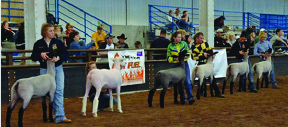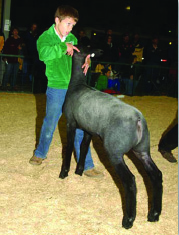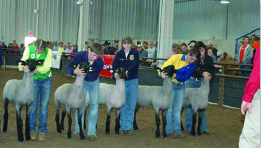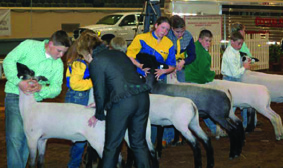Sheep Showmanship
Showmanship is an exhibitor’s ability to most effectively present an animal in a competitive yet positive attitude. A good showman is a person that has a sense or knack for an effective presentation of an animal. Showmanship is the one area of livestock showing in which the exhibitor has the most control. In showmanship a person is judged on their abilities to control and present their lamb to bring out its best characteristics. Advanced planning, practice, and hard work are keys to becoming a good showman. Lamb showmanship not only generates enthusiasm in the show ring, but also teaches many valuable lessons that can be used in day-to-day life. These lessons include responsibility, work ethic, determination to reach a goal, winning graciously, and accepting setbacks with dignity. Winning takes practice at home and can become a reality by working with the lamb.
Value of Working at Home
In the sheep project, working at home is vital to becoming a successful showman. All good showmen start early training and building a bond with their lamb. Once a lamb is weaned, immediately start spending time with your lamb. Talking to or touching the animal while it eats will allow it to get used to you, build trust, and allow it to become more comfortable with you. Remember that this process takes time and patience.
After the lamb is used to you, the halter breaking process should begin. The key thing to remember when halter breaking is to be extremely careful and ALWAYS watch your animal when it is tied up. If sheep are not watched closely, especially when they are first introduced to the halter, they could hurt or even kill themselves.
Here are some helpful hints to assist the initial halter breaking process:
- Start halter breaking early.
- Nylon sheep rope halters work best, are generally the easiest for people to use, and minimizes stress of the animal.
- Adjust the halter so the nose piece is halfway between the eyes and mouth.
- Tie the lamb up for 10 to 15 minutes while touching it all over to get the animal used to you.
- For the first few times you lead your lamb, try walking in the pen and leave more lead than what you would normally use. Do not apply much pressure to the halter. Simply let the animal get used to the feel of the halter. The lamb could possibly jump, fall, or twist once the halter is put on the first few times. Just remain patient, and comfort your lamb with voice rewards. Using hay or feed to reward your animal may also be helpful.
- Once your lamb gets used to the halter, you can firm up on your grip when you walk your lamb and choose an area to walk that is not enclosed. Lead your lamb with their head held high, so they walk naturally but still look appealing.
- When releasing your animal, gently remove the halter, maintaining control until you place them into their pen. If the animal gets away, they think they can repeatedly do it. Stay calm without jerking the halter away.
- Practice makes perfect—introduce your animal to all the procedures you will be following when you arrive at the show. It is important to set the lamb’s feet and legs properly as well as teaching the lamb how to brace. Occasionally, have another person handle your animal the way a judge would, so the animal becomes acquainted with this procedure. Allowing your animal to stand with their head held up high for about 20 minutes a day will teach them to keep their head high and be less stressful when they have to keep their head up in the show ring (Figure 1).

Figure 1. Side Profile. A more gentle lamb makes showmanship a much easier task. Working with your lamb at home will get the lamb used to the show atmosphere.
Leading for Exercise
The halter should be properly placed on the lamb’s head with the lead rope on the lamb’s left side. The halter strap that crosses over the muzzle or nose should be between the eyes and the nose. Rope halters and show halters can be adjusted for proper fit. If the halter is too small, it will get into the lamb’s eyes. If the halter is too big, the nose cross piece will be down too close to the mouth.
When leading, you should be on the lamb’s left side with the halter in your right hand. Your hand should be knuckle-side up with your smallest finger nearest the lamb, three to six inches from the animal’s head.
The halter length should be long enough for control, but not too long to allow you or the animal to become tangled in the halter. Halters should never touch the ground. Any extra length can be cut off. If the lamb is spooked, have two hands firmly gripped on the halter. Never wrap the halter around your hand or fingers because this could cause serious injury.
During a show, use of a halter is not recommended unless the exhibitor is smaller or younger in age. When not using a halter, place your right hand behind the sheep’s ears and your left hand under the lamb’s jaw with both thumbs facing your stomach. Never pull the lamb by their ears as this causes the lamb to pull back.
By the time you arrive at the show, your lamb should already be trained to lead and stand correctly. Observe where you are going in the show ring, checking to see if you are walking in a straight path. Walk straight ahead at a moderate pace. During the lead, your lamb’s head should be just high enough to present an impressive style, attractive side view and graceful walk. Let your lamb walk out freely and naturally, not too fast and not to slow.
Be aware of the animal in front of you, allowing space when walking or when setting
up for a side view. Be observant for signals and instructions from the judge and ring
official. When leading your lamb in a circle, move in a clockwise direction, putting
your lamb between you and the judge. One of the key points in lamb showmanship is
never to obstruct the judge’s view.
Even though you have trained your lamb to lead, sometimes your lamb may not cooperate at a show. When your lamb becomes stubborn and will not lead, keep your cool. Gently reach back and lift up on the lamb’s dock. The lamb will most likely react to this and start walking. Whether at a show or at home training, never hit a lamb with a rope halter or grab the lamb by the skin or wool. This can cause serious bruising to the lamb.
Special Term
Setting up an animal: A showmanship term referring to the proper placement of a lamb’s legs while being exhibited to a judge for evaluation. Your hand, boots or knee can help move the legs to the proper position under the animal so that the animal is presented at its best appearance from the side, front, or rear views.
Setting up Your Lamb
When stopped with an animal in the show ring, take one step to the left so you are in front of the animal. Keep hands on both sides of animal’s jaw, right behind the ears (Figure 2). Keep two to three feet between you and the next animal so you do not crowd. Proper distancing allows for a better view and aids the judge in viewing and handling your lamb. On a rear view (Figure 3) stand beside the lamb that was in front of you. When moving to a side view, the lambs will be lined up directly behind one another (Figure 1). It is important to keep a straight line. If you are blocking the view of another animal and have space, move so the judge can see all the animals.
If you are the one being covered up, it is your responsibility to get where the judge can see your animal. If you cannot get into your previous spot because it is too small, discretely pull to the end of the line so you can be seen.
Quickly, yet smoothly, set up your lamb with all four feet at the corners and the lamb’s weight evenly dispersed over its legs (Figure 2). Always set up the legs closest to the judge first. For example, if the judge is closest to your animal’s rear legs, set the rear legs of your animal first. When setting up your lamb, you have three tools: your hands, boots, and knees.
To move a leg into place, grab the leg above the hock with your hand. Position it into the intended spot. Smaller exhibitors may not be able to reach. In this case, the use of a boot may be helpful. Also, if a back leg needs to be moved backwards, simply pushing into the lamb with one knee may cause the animal to put the foot into place.
While your lamb is set up and the judge is appraising your animal, he or she may walk around your animal. It is important that you are aware the judge is coming. If the judge comes from the right side of your animal around the front of the animal’s head, you should be on the left side of the animal. When the judge comes even with you, take three steps and pivot to the other side of the lamb. Now you are standing on the right side of the lamb and the judge is on the left. This allows the judge to see more of your animal and lets them know you are aware of their location. Move the opposite way if the judge comes from the opposite direction.
Never place your hand on the lamb’s back or the base of the neck. This will obstruct the judge’s view of the lamb’s top.

Figure 2. Proper lamb set-up with feet square underneath.
Special Term
Bracing a lamb: Bracing is when you make your lamb flex their muscles in the leg and loin areas. The lamb will push into your body, making their muscles feel harder and more toned. It also makes the muscles appear larger and more pronounced. This practice is the same as when humans flex their arm muscles.
Bracing Your Lamb
Bracing your lamb will enhance a judge’s opinion of your lamb’s merit, so successful bracing is an important part of lamb showmanship. Once you have your lamb set up, be ready for the judge to come handle your animal. Train the lamb to brace or push against your knee. Keep your lamb in a light brace the whole time you are in the show ring. The only exceptions include when you are leading your lamb or when the judge comes to look at the front of your animal (Figure 3). When the judge comes to handle your lamb, push harder on your lamb to get the hardest brace possible (Figure 4).

Figure 3. Front view. Notice the animals are lined up in a straight line. Also, as the judge comes from the right, the exhibitors are on the left side of their lamb. Their hand placements is important with each hand on the sides of the jaw.
To brace the lamb, stand in front and hold it securely with it’s nose pointing slightly upward. Gently push back on the lamb with your knee placed in the lamb’s breast and shoulder area (Figure 4). Never pull up on the lamb’s neck with your hands. Instead, use your knees to control the animal. Keep all four legs on the ground. Picking your animal up off the ground is unacceptable.

Figure 4. When the judge handles your lamb, it is important that you “get a good brace.” Be ready and push into the lamb before the judge comes to handle.
After the judge handles your lamb, be sure you are still lined up straight and that your lamb’s legs are properly set up. After a brace, your lamb might often be out of place.
There are various ways to teach your lamb how to brace. Different people and different lambs respond to each idea in a unique way. Some lambs will even brace naturally with little to no training or effort on your part. Remember, it is never acceptable to slap or hit a lamb whether at home or in the showring.
Teaching methods for bracing include:
- Backing the lamb off a ledge such as a blocking stand or trailer loading dock—by slowly pushing the lamb back, they will be scared of falling, causing them to drive into you. Don’t actually push the lamb off, but letting one foot step off might do the trick.
- Backing the lamb into water—a ditch or something of that sort works great to back a lamb against because they do not like water. If they get water on their feet they will try to get away from it by driving into you.
- Backing the lamb into a wall or fence—when the lamb has no where else to go, it will push forward.
- Set the lamb on a steep hill—having the lamb’s front end on the top of the hill will make the lamb brace in fear that it will fall down the hill.
Appearance
The animal should be clean, well-groomed and clipped in those areas as acceptable or recognized for the breed or sex. The wool should be short shorn for market animals and blocked out for breeding sheep. A good grooming job exemplifies pride of ownership by the exhibitor. Many hours spent preparing your animal in advance of the show will be evident in the show ring.
You should be neat and clean just as the lamb should be well-groomed. Remember, the audience looks at you too.Fancy clothes are not necessary, but neatness and cleanliness are important. It is recommended that you wear appropriate clothing consisting of a tucked-in sleeved shirt, leather boots or shoes, jeans, and a belt. Avoid faded blue jeans and T-shirts. Instead, a more professional look is better. Check the show regulations concerning dress code and always comply with the requirements such as wearing specific clothing.
Practice good posture in showmanship. It is the proper thing to do and will keep your lamb calm. Stand with your back straight. Never lean back. If you must lean, lean slightly forward as this expresses a positive interest of concern, as if you were getting into a good action movie and were leaning forward. Keep your feet relatively close together. Never let your feet become farther than shoulder width apart.
When your animal is stopped, you may choose to scratch your animal with a long, calm stroke of your hand on their neck or belly. A fast stroke only shows that you are nervous and can make your lamb more nervous, defeating the purpose.
Always be aware of the judge’s location; however, do not concentrate on the judge so much that you forget about your animal and the animals around you. Your first obligation is to your lamb, so keep checking to see that it is standing correctly and that it is in the proper position. Be ready to move if the judge signals, or answer any questions about your lamb, such as age, breeding program, retail cuts, harvesting information, breed type, or feeding program.
Show Time!
When you arrive at the show, check the show ring for low spots or dark areas. This will help you avoid these areas when setting up your lamb, both improving the appearance of your animal and impressing the judge. If possible, every time you stop your animal, position the front legs on slightly higher ground and in a well lit area.
Be sure to know the show schedule and be ready when the class is called. A late arrival in the show ring may cause some confusion or distract the judge. It is wise to confirm that your lamb is entered in the correct class. Animals entered in the wrong class cause confusion and slow down the show. If the show requires each exhibitor to have an entry card before entering the ring, make sure you have the card, and any other required record or identification. Observe the judging of a few classes prior to showing to familiarize yourself with ring procedures at each show and the judge’s preferred show style.
The first thing to do when entering the show ring is to look for the ring official who is lining up your class. The ring official is there to help organize the class and minimize distractions for the judge. Be alert at all times, and carry out the instructions of the judge and ring officials closely.
One way to practice good sportsmanship is to assist others when you can. For example, if an animal stops in front of you, don’t wait for the ring assistant to come help. Instead, use your right hand to push the dock of the animal in front of you. Keep your left hand underneath your lamb’s jaw for control. This will keep the show moving properly and the judge will recognize that you care about the success of others and not just yourself.
When the judge starts his reasons, he or she may or may not have their final placing, therefore the class is not over. Continue to work hard and display good sportsmanship. Leave the ring in an orderly manner as instructed by the ring steward, and pick up your award.
Special Term
Good Sportsmanship: Occurs when opponents, show team members, officials, staff, and audience good sportsmanship—practicing proper etiquette at all times within the showring. The real winners are those who know how to persevere and to behave with dignity—whether they win or lose.
Have Fun and Do Your Best
Always be courteous to show officials, the judge, and other exhibitors. Good sportsmanship is an important part of showmanship; therefore, you will win graciously and accept setbacks with dignity. Show your appreciation for the sponsorship of the show by writing thank you notes. Be a good representative of your club, school, county, and family. Work hard, practice at home, always try to do better next time and profit from your mistakes as you gain experience. Above all have fun!
Rusty Gosz
Extension Youth Livestock Specialist
Cassie Bacon
Animal Science Student Intern
